
1
Contents
Language Page
____________________________________________________________________________
English 1
French 29
Spanish
2
Topic Page
Inventory of Contents 2
Features 3
Setting Up
Battery Installation 7
Function keys 9
LCD Screen and Settings 11
Manual Settings 13
Viewing the minimum and maximum records 24
Ressetting the minimum and maximum records 24
915 MHz Reception 27
Mounting 28
Care and Maintenance 31
Specifications 32
Warranty Information 33
3
INVENTORY OF CONTENTS
1. Wireless Temperature Station
2. Wireless Outdoor Temperature Transmitter (TX29U-IT) and mounting bracket
3. Instruction Manual.
This product offers:
INSTANT TRANSMISSION is the state-of-the-art new
wireless transmission technology, exclusively designed
and developed by LA CROSSE TECHNOLOGY. INSTANT
TRANSMISSION offers you an immediate update (every
4 seconds!) of all your outdoor data measured from the
sensors: follow your climatic variations in real-time!
4
LCD
Display
Hanging hole
Battery
compartment
cover
Foldout
stand
Function Keys
FEATURES:
The Temperature Station

5
• Quartz clock in 12 or 24-hour time display (hour and minute, manually set)
• Indoor and outdoor temperature reading in degrees Fahrenheit (°F) or Celsius (°C)
• Display of MIN/MAX records of indoor temperature and outdoor temperature
• Can receive up to three outdoor transmitters
• Wireless transmission at 915 MHz
• Signal reception intervals at 4 seconds
• Low battery indicator
• Wall mounting or table standing (foldout table stand)
The Outdoor Temperature Transmitter
• Remote transmission of outdoor temperature to Temperature
Station by 915 MHz
• Rain resistant casing
• Wall mounting case (Mounting at a sheltered place. Avoid direct
rain and sunshine)
6
SETTING UP:
When one transmitter is used:
1. First, insert the batteries into the transmitter (see “How to install and replace batteries in the
Temperature transmitter” below).
2. Within 30 seconds of powering up the transmitter, insert the batteries to the Temperature Station (see
“How to install and replace batteries in the Temperature Station” below). Once the batteries are in
place, all segments of the LCD will light up briefly. Then the indoor temperature and the time as 12:00 will
be displayed. If they are not shown on LCD after 60 seconds, remove the batteries and wait for at least
60 seconds before reinserting them. Once the indoor data is displayed, user may proceed to the next
step.
3. After the batteries are inserted, the Temperature Station will start receiving data signal from the
transmitter.
4. The outdoor temperature should be displayed on the Temperature Station. Also, the signal reception icon
will be displayed. If this does not happen after 2 minutes, the batteries will need to be removed from both
units and reset from step 1.
5. In order to ensure sufficient 915 MHz transmission, the final position between the Temperature Station
and the transmitter should not be more than 330 feet / 100 meters (see notes on “Positioning” and “915
MHz Reception”).
6. Batteries are the #1 warranty issue we see. Please be sure you are using name brand plain alkaline
batteries dated at least 7 years in advance or testing to 1.48 on a voltmeter that reads in numbers.
7
When more than one transmitter is used
1. User shall remove all the batteries from the Temperature Station and transmitters and wait
60 seconds if setting has been done with one transmitter first.
2. Insert the batteries to the first transmitter.
3. Within 30 seconds of powering up the first transmitter, insert the batteries to the
Temperature Station. Once the batteries are in place, all segments of the LCD will light up
briefly. Following time as 12:00 will be displayed. If the time is not shown in LCD after 60
seconds, remove the batteries and wait for at least 60 seconds before reinserting them.
4. The outdoor temperature from the first transmitter (channel 1) should then be displayed on
the Temperature Station. Also, the signal reception icon will be displayed. If this does not
happen after 2 minutes, the batteries will need to be removed from both units and reset
from step 1.
5. Insert the batteries to the second transmitter as soon as the outdoor temperature readings
from the first transmitter are displayed on the Temperature Station.
Note: User shall insert the batteries into the second transmitter within 10 seconds of reception
of the first transmitter.
8
6. The outdoor temperature from the second transmitter and the "channel 2" icon should
then be displayed on the Temperature Station. If this does not happen after 2 minute, the
batteries will need to be removed from all the units and reset from step 1.
7. Insert the batteries to the third transmitter as soon as the "channel 2" icon and outdoor
temperature data is displayed on the Temperature Station. Then within 2 minutes, the
channel 3 outdoor data from the third transmitter will be displayed and the channel icon
will shift back to "1" once the third transmitter is successfully received. If this is not
happen, user shall restart the setting up from step 1.
Note: User shall insert the batteries into the third transmitter within 10 seconds of reception of
the second transmitter.
8. In order to ensure sufficient 915 MHz transmission there should be no more than 330
feet (100 meters) between the final position of the Temperature Station and the
transmitter (see notes on “Mounting” and “915 MHz Reception”).
Note:
If the signal reception is not successful on the first frequency (915MHz) for 40 seconds, the
frequency is changed to 920MHz and the learning is tried another 40 seconds. If still not

9
successful the reception is tried for 40 seconds on 910MHz. This will also be done for re-
synchronization.
IMPORTANT:
Transmission problems will arise if the setting for additional transmitters is not followed as
described above. Should transmission problems occur, it is necessary to remove the batteries
from all units and start again the set-up from step 1.
HOW TO INSTALL AND REPLACE BATTERIES IN THE TEMPERATURE TRANSMITTER
The Temperature transmitter uses 2 x AA, IEC LR6, 1.5V batteries. When
batteries will need to be replaced, the low battery icon will appear on the
LCD of the Temperature Station. To install and replace the batteries, please
follow the steps below:
1. Remove the battery compartment cover.
2. Insert the batteries, observing the correct polarity (see marking).
3. Replace the battery holder to the unit.
Note:
In the event of changing batteries in any of the units, all
units need to be
10
reset by following the setup procedures. This is because a random security code is assigned by
the transmitter at start-up and this code must be received and stored by the Temperature
Station in the first few minutes of power supplying.
HOW TO INSTALL AND REPLACE BATTERIES IN THE TEMPERATURE STATION
The Temperature Station uses 2 x AAA, IEC LR3, 1.5V batteries.
When batteries will need to be replaced, the low battery icon will
appear on the LCD. To install and replace the batteries, please follow
the steps below:
1. Lift up the battery compartment cover.
2. Insert batteries observing the correct polarity (see marking).
3. Replace compartment cover.
BATTERY CHANGE:
It is recommended to replace the batteries in all units every 12 months to ensure optimum
accuracy of these units.
11
Please participate in the preservation of the environment. Return used batteries
to an authorised depot.
FUNCTION KEYS:
Temperature Station:
The Temperature Station has only four easy to use function keys.
+ key
Min/max key
Set Key
Channel key
12
SET key (Setting)
• Press and hold for about 3 seconds to enter the Manual setting mode: 12/24 hour time
display, and manual time settings
MIN/MAX key (Min/ Max temperature)
• Used to toggle between the minimum and maximum recorded readings of indoor &
outdoor temperature.
• Press and hold to reset minimum and maximum record when min or max record is shown.
+ key (Plus)
• To make adjustments for manual settings.
CH key (Channel)
• To toggle between the Outdoor transmitters 1, 2 and 3 (if more than 1 transmitter is used)

13
Receiver Low
battery indicator
LCD Screen and settings:
Transmitter Low
battery indicator
Outdoor Temperature
in °F/°C
Outdoor Reception
Signal icon*
Indoor
Temperature in °F/°C
Time
Sensor identification No.
(shown when more than
one sensor is used)
14
*When the signal is successfully received by the Temperature Station, this icon will be switched
on. (If not successful, the icon will not be shown in LCD) So the user can easily see whether the
last reception was successful (icon on) or not (icon off). On the other hand, the short blinking of
the icon shows that a reception is being done now.
For better distinctness the LCD screen is split into 3 sections displaying the information for time,
indoor temperature, and outdoor temperature.
Section 1 - TIME
• Display of time.
Section 2 - INDOOR TEMPERATURE
• Display of indoor temperature
Section 3 - OUTDOOR TEMPERATURE
• Display of the outdoor temperature
15
MANUAL SETTING:
12/24- HOUR TIME DISPLAY SETTING AND TEMPERATURE UNIT (°C/°F) SETTING
To display the time in 12-hour or 24-hour mode (default setting: 12h):
1. In normal display mode, press and hold the SET key for about 3 seconds. The "12h" or
"24h" digit will be flashing.
2. Press the + key to set the desired time display mode.
3. Press shortly the SET key to advance to the MANUAL TIME SETTING.
Note:
When the time display is set as 12-hour mode, the temperature unit will be fixed to °F; when the
time mode is in 24-hour, the temperature unit will be fixed to °C.
Flashing
16
MANUAL TIME SETTING
Set the time of Temperature Station by the following steps:
1. The hour digit of the time display will be flashing.
2. Press the + key to adjust the hour (Press and hold to allow fast advancing). Press SET
key to confirm and go to the minute setting.
3. The minute digit will be flashing. Press the + key to adjust the minute (Press and hold to
allow fast advancing).
4. Press SET key once more to return to normal display.
VIEWING THE MINIMUM AND MAXIMUM RECORDS:
To view the MIN/MAX indoor and outdoor temperature records:
1. Press the MIN/MAX key once to view the minimum indoor and outdoor temperature.
Minutes
(flashing)
Hours
(flashing)

17
2. Press the MIN/MAX key once more to view the maximum indoor and outdoor temperature.
3. Press the MIN/MAX key to return to current temperature display.
When several transmitters are used:
1. Select the desired channel first by pressing the CH key.
2.
Press the MIN/MAX key to view the selected MIN/MAX records of selected channel.
Minimum icon
Maximum icon
18
Note: The transmitter number will only be displayed if more than one transmitter is used.
RESETTING THE MINIMUM AND MAXIMUM RECORDS:
To reset the MIN/MAX records:
1. Press the MIN/MAX key once to display the min record.
2. Press and hold the MIN/MAX key again for about 3 seconds to reset all the minimum/
maximum data to the current temperature values.
Note: All indoor and outdoor MIN/MAX records from all transmitters will be reset at the
same time.
TEMPERATURE TRANSMITTER:
The outdoor temperature is measured and transmitted to the Temperature Station every 4
seconds approximately.
The range of the Temperature Transmitter may be affected by the temperature. At cold
temperatures, the transmitting distance may be decreased. Please bear this in mind when
placing the transmitter.
19
915 MHz RECEPTION CHECK
The Temperature Station should receive the temperature data within few minutes after set-up. If
the temperature data is not being received about 2 minutes after setting up (the display shows “-
- -” after consecutive failures in receiving signal for times), please check the following points:
1. The distance of the Temperature Station or transmitter should be at least 5 to 6.5 feet
(1.5 to 2 meters) away from any interfering sources such as computer monitors or TV
sets.
2. Avoid positioning the Temperature Station onto or in the immediate proximity of metal
window frames.
3. Using other electrical products such as headphones or speakers operating on the same
signal frequency (915MHz) may prevent correct signal transmission and reception.
4. Neighbours using electrical devices operating on the 915MHz signal frequency can also
cause interference.
Note:
When the 915MHz signal is received correctly, do not re-open the battery cover of either the
transmitter or Temperature station, as the batteries may spring free from the contacts and force
20
a false reset. Should this happen accidentally then reset all units (see Setting up above)
otherwise transmission problems may occur.
The transmission range is about 330 feet / 100 m from the transmitter to the Temperature
Station (in open space). However, this depends on the surrounding environment and
interference levels. If no reception is possible despite the observation of these factors, all
system units have to be reset (see Setting up).
LOW BATTERY INDICATOR
Low battery indicators are displayed on the LCD when the batteries require changing.
POSITIONING THE TEMPERATURE STATION:
The Temperature Station comes attached with foldout table stand, which provides the option of
table standing or wall mounting the unit. Before wall mounting, please check that the outdoor
temperature values can be received from the desired locations.

21
Free standing
With the foldout stand, the Temperature Station can be placed onto any flat
surface.
To wall mount
1. Fix a screw (not supplied) into the desired wall, leaving the head
extended out the by about 5mm.
2. Hang the temperature station onto the screw. Remember to ensure that
it locks into place before releasing.
22
POSITIONING THE TEMPERATURE TRANSMITTER:
The Transmitter is supplied with a holder that may be attached to a wall
with the two screws supplied. The Transmitter can also be position on a
flat surface by securing the stand to the bottom to the Transmitter.
To wall mount:
1. Secure the bracket onto a desired wall using the screws and plastic
anchors.
2. Clip the remote temperature transmitter onto the bracket.
Note: In order to get an accurate reading and to prolong the life of your
sensor we recommend that you have it in a sheltered area out of the sun
and direct rain. Fog and Mist will not affect the sensor, but a soaking in
23
water may. You can mount it outside under an eve of your house or any other suitable place
that will keep it out of the sun and rain. Do not wrap the sensor in plastic or seal it in a plastic
bag as these can cause condensation problems and substantially reduced accuracy. Please
note a sensor in the Sun will provide inaccurate temperature readings.
Before permanently fixing the transmitter wall base, place all units in the desired locations to
check that the outdoor temperature reading is receivable. In event that the signal is not
received, relocate the transmitter(s) or move them slightly as this may help the signal reception.
CARE AND MAINTENANCE:
• Extreme temperatures, vibration and shock should be avoided as these may cause
damage to the unit and give inaccurate forecasts and readings.
• When cleaning the display and casings, use a soft damp cloth only. Do not use solvents
or scouring agents as they may mark the LCD and casings.
• Do not submerge the unit in water.
• Immediately remove all low powered batteries to avoid leakage and damage. Replace
only with new batteries of the recommended type.
24
• Do not make any repair attempts to the unit. Return them to their original point of
purchase for repair by a qualified engineer. Opening and tampering with the unit may
invalidate their guarantee.
• Do not expose the units to extreme and sudden temperature changes, this may lead to
rapid changes in forecasts and readings and thereby reduce their accuracy.
SPECIFICATIONS:
Temperature measuring range
Indoor : 14.2ºF to +139.8ºF with 0.2ºF / -9.9ºC to +59.9ºC with 0.1ºC resolution
(“OF.L” displayed if outside this range)
Outdoor : -39.8ºF to +139.8ºF with 0.2ºF / -39.9ºC to +59.9ºC with 0.1ºC resolution
(“OF.L” displayed if outside this range)
Indoor Temperature checking interval : every 15 second
Outdoor data checking interval : every 4 second
Power Supply
Temperature Station : 2 x AAA, IEC LR3, 1.5V
Outdoor Temperature Transmitter : 2 x AA, IEC LR6, 1.5V

25
Battery life cycle : approximately 12 months (Alkaline batteries recommended)
Dimensions (L x W x H)
Temperature Station : 3.3” x 0.88” x 5.86” / 84 x 22.6 x 149mm
Outdoor Temperature Transmitter : 1.5” x 0.83” x 5.05” / 38.2 x 21.2 x 128.3mm
WARRANTY
La Crosse Technology, Ltd provides a 1-year limited warranty on this product against
manufacturing defects in materials and workmanship.
This limited warranty begins on the original date of purchase, is valid only on products
purchased and used in North America and only to the original purchaser of this product. To
receive warranty service, the purchaser must contact La Crosse Technology, Ltd for problem
determination and service procedures. Warranty service can only be performed by a La Crosse
Technology, Ltd authorized service center. The original dated bill of sale must be presented
upon request as proof of purchase to La Crosse Technology, Ltd or La Crosse Technology,
Ltd’s authorized service center.
26
La Crosse Technology, Ltd will repair or replace this product, at our option and at no charge as
stipulated herein, with new or reconditioned parts or products if found to be defective during the
limited warranty period specified above. All replaced parts and products become the property of
La Crosse Technology, Ltd and must be returned to La Crosse Technology, Ltd. Replacement
parts and products assume the remaining original warranty, or ninety (90) days, whichever is
longer. La Crosse Technology, Ltd will pay all expenses for labor and materials for all repairs
covered by this warranty. If necessary repairs are not covered by this warranty, or if a product
is examined which is not in need or repair, you will be charged for the repairs or examination.
The owner must pay any shipping charges incurred in getting your La Crosse Technology, Ltd
product to a La Crosse Technology, Ltd authorized service center. La Crosse Technology, Ltd
will pay ground return shipping charges to the owner of the product to a USA address only.
Your La Crosse Technology, Ltd warranty covers all defects in material and workmanship with
the following specified exceptions: (1) damage caused by accident, unreasonable use or neglect
(including the lack of reasonable and necessary maintenance); (2) damage occurring during
shipment (claims must be presented to the carrier); (3) damage to, or deterioration of, any
accessory or decorative surface; (4) damage resulting from failure to follow instructions
contained in your owner’s manual; (5) damage resulting from the performance of repairs or
alterations by someone other than an authorized La Crosse Technology, Ltd authorized service
27
center; (6) units used for other than home use (7) applications and uses that this product was
not intended or (8) the products inability to receive a signal due to any source of interference..
This warranty covers only actual defects within the product itself, and does not cover the cost of
installation or removal from a fixed installation, normal set-up or adjustments, claims based on
misrepresentation by the seller or performance variations resulting from installation-related
circumstances.
LA CROSSE TECHNOLOGY, LTD WILL NOT ASSUME LIABILITY FOR INCIDENTAL,
CONSEQUENTIAL, PUNITIVE, OR OTHER SIMILAR DAMAGES ASSOCIATED WITH THE
OPERATION OR MALFUNCTION OF THIS PRODUCT. THIS PRODUCT IS NOT TO BE
USED FOR MEDICAL PURPOSES OR FOR PUBLIC INFORMATION. THIS PRODUCT IS
NOT A TOY. KEEP OUT OF CHILDREN’S REACH.
This warranty gives you specific legal rights. You may also have other rights specific to your
State. Some States do no allow the exclusion of consequential or incidental damages therefore
the above exclusion of limitation may not apply to you.
For warranty work, technical support, or information contact:
La Crosse Technology, Ltd
28
2809 Losey Blvd. South
La Crosse, WI 54601
Phone: 608.782.1610
Fax: 608.796.1020
e-mail:
(warranty work)
(information on other products)
web:
www.lacrossetechnology.com
Question? Instructions? Please visit:
www.lacrossetechnology.com/9160

29
All rights reserved. This handbook must not be reproduced in any form, even in excerpts, or duplicated or
processed using electronic, mechanical or chemical procedures without written permission of the publisher.
This handbook may contain mistakes and printing errors. The information in this handbook is regularly checked
and corrections made in the next issue. We accept no liability for technical mistakes or printing errors, or their
consequences.
All trademarks and patents are acknowledged.
-
 1
1
-
 2
2
-
 3
3
-
 4
4
-
 5
5
-
 6
6
-
 7
7
-
 8
8
BIOS WS9160 Station de Température User manual
- Type
- User manual
- This manual is also suitable for
Ask a question and I''ll find the answer in the document
Finding information in a document is now easier with AI
Other documents
-
 La Crosse Technology WS-9121U-IT User manual
La Crosse Technology WS-9121U-IT User manual
-
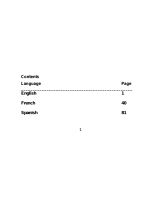 La Crosse Technology WS-9125TWC-IT User manual
La Crosse Technology WS-9125TWC-IT User manual
-
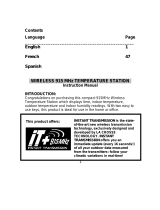 La Crosse Technology WS-9124TWC-IT User manual
La Crosse Technology WS-9124TWC-IT User manual
-
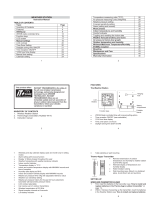 La Crosse Technology wireless weather station User manual
La Crosse Technology wireless weather station User manual
-
La Crosse WS-9057U-IT User manual
-
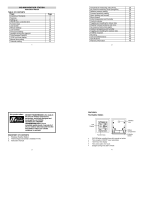 La Crosse Technology wireless weather station User manual
La Crosse Technology wireless weather station User manual
-
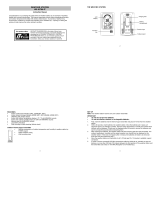 La Crosse Technology WS-9170U-IT User manual
La Crosse Technology WS-9170U-IT User manual
-
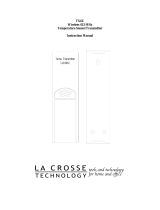 La Crosse Technology TX6U User manual
La Crosse Technology TX6U User manual
-
La Crosse Tomorrow's Weather Today TX29U Owner's manual
-
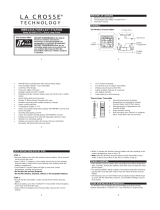 La Crosse Technology WS-9057U-IT-LC Quick Setup Manual
La Crosse Technology WS-9057U-IT-LC Quick Setup Manual















